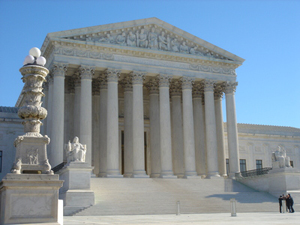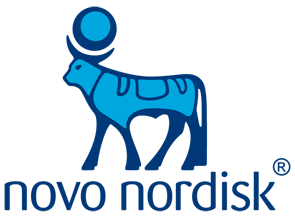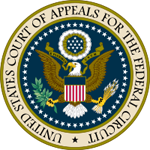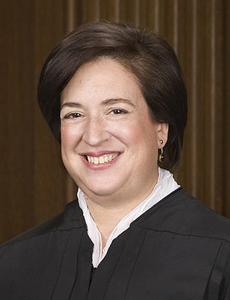[author: Kevin E. Noonan]
 On April 17th, the Supreme Court overturned a Federal Circuit decision construing statutory language involving the 2003 Medicare Prescription Drug Improvement and Modernization Act, which amended the 1984 Drug Price Competition and Patent Term Restoration Act (colloquially known as the Hatch-Waxman Act). The decision was certainly not a surprise, to put it mildly; indeed, the surprise is when the Court affirms a Federal Circuit decision. But that doesn't mean the Court is wrong, it just reflects the differences in the way the two appellate courts view the world and their respective places in it.
On April 17th, the Supreme Court overturned a Federal Circuit decision construing statutory language involving the 2003 Medicare Prescription Drug Improvement and Modernization Act, which amended the 1984 Drug Price Competition and Patent Term Restoration Act (colloquially known as the Hatch-Waxman Act). The decision was certainly not a surprise, to put it mildly; indeed, the surprise is when the Court affirms a Federal Circuit decision. But that doesn't mean the Court is wrong, it just reflects the differences in the way the two appellate courts view the world and their respective places in it.
The statutory provisions at issue involve the requirements for listing patents claiming drug products or their uses in the Orange Book. The statute requires an innovator and approved New Drug Application (NDA) holder to identify these patents by patent number and expiration date. For patents claiming uses (more properly, methods of use) of a regulated drug, the FDA proscribes "use codes" which are published in the Orange Book as well.
For a use not covered by an Orange Book listed patent, a generic drug manufacturer who files an Abbreviated New Drug Application (ANDA) must submit a proposed label for the unpatented use as well as a statement under 21 U.S.C. § 355(j)(2)(A)(viii) (a "Section viii" statement) that the use does not infringe any listed patent. Approval of the ANDA requires that the proposed label does not overlap (to any extent) any patented method (termed a "carve-out").
As part of the litigation provisions of the Hatch-Waxman Act, an ANDA filer can file a counterclaim in ANDA litigation that challenges the accuracy of the patent information submitted by the innovator, inter alia, that the patent doesn't claim an approved method for using the drug (which is defined by the use codes and the innovator drug label):
[The ANDA] applicant may assert a counterclaim seeking an order requiring the holder to correct or delete the patent information submitted by the holder under subsection (b) or (c) of this section on the ground that the patent does not claim either--
(aa) the drug for which the application was approved; or
(bb) an approved method of using the drug.
21 U.S.C. § 355(j)(5)(c)(ii)(I)
 The case involves Novo Nordisk's repaglinide drug product marketed as PRANDIN®. Novo listed two patents in the Orange Book associated with this drug: Reissue Patent No. RE37,035, which claims the repaglinide drug product itself and expired March 14, 2009. The other patent, U.S. Patent No. 6,677,358, claims the method of using repaglinide in combination with metformin; this patent expires June 12, 2018. There are two other approved uses for PRANDIN®: as monotherapy and in combination with thiazolidinediones (TZD's), but neither of these indications is claimed in any Orange Book listed patent. All indications are for treating Type 2 (adult-onset) diabetes.
The case involves Novo Nordisk's repaglinide drug product marketed as PRANDIN®. Novo listed two patents in the Orange Book associated with this drug: Reissue Patent No. RE37,035, which claims the repaglinide drug product itself and expired March 14, 2009. The other patent, U.S. Patent No. 6,677,358, claims the method of using repaglinide in combination with metformin; this patent expires June 12, 2018. There are two other approved uses for PRANDIN®: as monotherapy and in combination with thiazolidinediones (TZD's), but neither of these indications is claimed in any Orange Book listed patent. All indications are for treating Type 2 (adult-onset) diabetes.
 Caraco filed an ANDA for generic repaglinide having a Paragraph III certification regarding the '035 patent and a Paragraph IV certification for the '358 patent, the latter leading to ANDA litigation pursuant to 35 U.S.C. § 271(e)(2). During the litigation, Caraco stipulated in that action that its ANDA would infringe the '358 patent if it included a label describing the combination of repaglinide and metformin, and at the same time submitting an amended ANDA with a Paragraph IV certification and a Section viii statement that its ANDA would not seek approval for the repaglinide + metformin combination. The "carve-out" label was acceptable to FDA.
Caraco filed an ANDA for generic repaglinide having a Paragraph III certification regarding the '035 patent and a Paragraph IV certification for the '358 patent, the latter leading to ANDA litigation pursuant to 35 U.S.C. § 271(e)(2). During the litigation, Caraco stipulated in that action that its ANDA would infringe the '358 patent if it included a label describing the combination of repaglinide and metformin, and at the same time submitting an amended ANDA with a Paragraph IV certification and a Section viii statement that its ANDA would not seek approval for the repaglinide + metformin combination. The "carve-out" label was acceptable to FDA.
However, at that time the FDA changed the use code associated with Novo's PRANDIN® product. The original use code, U-546, specified the combination of repaglinide + metformin to lower blood glucose. The FDA changed this use code to U-968, for "a method for improving glycemic control in adults with Type 2 diabetes." This use code was not limited to the specific repaglinide + metformin combination, and indeed was not expressly limited to Novo's drug (i.e., it could encompass metformin monotherapy. (There was some dispute at the Federal Circuit regarding whether the FDA changed the use code sua sponte.)
This change in the use code caused the FDA to reject Caraco's Section viii certification and "carve-out" label, requiring Caraco to include the rapaglinide + metformin combination on its label. Since Caraco stipulated that this combination was an infringement, the FDA's decision essentially mandated judgment for Novo absent a finding at trial of invalidity or unenforceability. In response to the FDA's determination, Caraco counterclaimed for a court order that the FDA return the use code to U-546. The District Court granted summary judgment on this issue, granting Caraco the requested order and ordered Novo to request the FDA to change the use code in the Orange Book for Prandin® from U-968 to its former U-546 listing.
 The Federal Circuit opinion, by Judge Rader joined by Judge Clevenger (with concurring opinions by Judge Clevenger and a dissenting opinion by Judge Dyk) held that the statute contained no provisions permitting an ANDA defendant to request or a district court to grant such an injunction, reversing the decision and vacating the injunction (see "Novo Nordisk A/S v. Caraco Pharmaceutical Laboratories, Ltd. (Fed. Cir. 2010)").
The Federal Circuit opinion, by Judge Rader joined by Judge Clevenger (with concurring opinions by Judge Clevenger and a dissenting opinion by Judge Dyk) held that the statute contained no provisions permitting an ANDA defendant to request or a district court to grant such an injunction, reversing the decision and vacating the injunction (see "Novo Nordisk A/S v. Caraco Pharmaceutical Laboratories, Ltd. (Fed. Cir. 2010)").
The question at the Federal Circuit was whether the statutory language of "an approved method" means "any approved method" (Novo's position) or "all approved methods" (Caraco's position). In finding for Novo, the Federal Circuit found "no ambiguity" in the language of the statute:
When an indefinite article is preceded and qualified by a negative, standard grammar generally provides that "a" means "any." See, e.g., American Heritage Dictionary of the English Language 1 (4th Ed. 2006).
The Federal Circuit concluded that Caraco can assert its counterclaim only if no patent listed in the Orange Book claims "any approved methods of using the listed drug," which was not the case here. In addition to this construction of the statutory language, the Federal Circuit also referenced the legislative history "to make sure that it does not contain any clear intent to the contrary" and concluded that the counterclaim provisions of the statute were devoid of a "private cause of action to delist an allegedly irrelevant patent from the Orange Book." The Federal Circuit also indicated that its interpretation was supported by the public policy concern that the combination of a Section viii certification and ANDA litigation "ensure that a generic drug [approved] for non-patented purposes will not be used for patented purposes via a simple section viii certification." The Federal Circuit opinion also asserted that the statute had no provisions permitting a generic drug maker to obtain an order from a court to compel a patent holder to change or modify its use code. The plain language of the statute authorizes the generic drug maker to "request an order compelling the 'holder to correct or delete the patent information submitted by the holder'," where "patent information" is limited to "the patent number and the expiration date.") (emphases in original).
Judge Dyk dissented on public policy grounds, stating that this construction was contrary to the "manifest purpose" of the statute, allowing "the same manipulative practices" the statute was passed to prevent, i.e., "delay[ing] the onset of competition from generic drug manufacturers." Since the FDA "repeatedly declined to police Orange Book listings," and the Federal Circuit refused to let ANDA filers use declaratory judgment jurisdiction to do so (Mylan Pharms. Inc. v. Thompson), Congress intervened by passing the 2003 amendments, including the Section viii certification provisions thereof according to Judge Dyk. (Ironically, in a footnote the Supreme Court indicates that on remand the District Court found the '358 patent to be invalid an unenforceable.)
 In its unanimous opinion, authored by Justice Kagan (with a concurring opinion by Justice Sotomayor), the Supreme Court construed the statute to provide a generic ANDA applicant to challenge inaccurate use codes and designations under the counterclaim provisions of the statute. Specifically, the Court construed the phrases the "patent does not claim . . . an approved method of using" a drug and the "patent information submitted . . . under subsection (b) or (c)" of § 355, both in the "context" of another statutory phrase, that the counterclaim is brought to "correct or delete" in accurate patent information. The Court found neither party's position on the issue to be "plausible," and thus applied a "statutory context" analysis to decide the question. This favored Caraco's position, because it is consistent with Congressional intent to get generic drugs to market quickly, particularly for uses not falling within the scope of Orange Book listed patents. ("The statutory scheme, in other words, contemplates that one patented use will not foreclose marketing a generic drug for other unpatented ones.")
In its unanimous opinion, authored by Justice Kagan (with a concurring opinion by Justice Sotomayor), the Supreme Court construed the statute to provide a generic ANDA applicant to challenge inaccurate use codes and designations under the counterclaim provisions of the statute. Specifically, the Court construed the phrases the "patent does not claim . . . an approved method of using" a drug and the "patent information submitted . . . under subsection (b) or (c)" of § 355, both in the "context" of another statutory phrase, that the counterclaim is brought to "correct or delete" in accurate patent information. The Court found neither party's position on the issue to be "plausible," and thus applied a "statutory context" analysis to decide the question. This favored Caraco's position, because it is consistent with Congressional intent to get generic drugs to market quickly, particularly for uses not falling within the scope of Orange Book listed patents. ("The statutory scheme, in other words, contemplates that one patented use will not foreclose marketing a generic drug for other unpatented ones.")
The Court also makes quick work of the question of whether use codes are "patent information" under the statute, holding that they "surely qualify." Citing Eli Lilly & Co. v. Medtronic, Inc., 496 U.S. 661 (1990), the Court holds that while the statute recites that "patent information" is the patent number and expiration date by the plain meaning of the statutory language, "neighboring" provisions of the statute and the use of the broad term "under" in citing the specific sections convinced the Court that use codes should be encompassed within the scope of the counterclaim statute. These use codes are "pivotal" to implementation of the Hatch-Waxman Act (despite having been enacted almost twenty years after the Act itself), according to the opinion, justifying (for the Court) the "broad sweep" of the counterclaim provisions.
Finally, the Court rejected Novo's argument that Congress merely intended to remedy a deficiency in the law resulting from the Federal Circuit's earlier decision in Mylan Pharmaceuticals, Inc. v. Thompson, 268 F. 3d 1323 (Fed. Cir. 2001), to enable generic applicants to remove an improperly listed patent from the Orange Book. According to the Court, Congress intended to supply generic drug applicants with a means to challenge the "accuracy" of a branded drug's patent listings; this conclusion is supported, according to the opinion, by provisions that not only permit a generic applicant to challenge branded drugs having "baseless" Orange Book patent designations (the situation in Mylan), but also instances where the designation is merely wrong. The opinion also notes and is seemingly influenced by) a Federal Trade Commission report that alleged branded drug companies to be listing inaccurate patent information in the Orange Book to delay generic drug approval, something the Court considers to provide the motivation for Congress to have enacted the counterclaim provisions.
In her concurring opinion, Justice Sotomayor argues that the statutory regime of ANDA filing, suit under § 271(e)(2), counterclaim assertion by the generic drug maker, "correction" of the use codes followed by resubmission of the ANDA, and the Section viii certification is flawed because "it results in delay and expense the statutory scheme does not envision" and "there is no guarantee the process will work," either because the generic drug maker will not prevail on its counterclaim or, even more troublesome, the branded drug maker will not file suit under § 271(e)(2). Under these circumstances, the FDA will be able to approve the ANDA, but the generic is then forced to launch at risk of a patent infringement lawsuit if it markets a generic product that falls within the scope of a use that is patented. She takes the Agency to task for this situation, calling the relevant regulations "remarkably opaque" and suggests that Congress has created precisely the "excessive litigation" it sought to avoid in enacting the statute in the first place.
Caraco Pharmaceutical Laboratories, Ltd. v. Novo Nordisk A/S (2012)
Opinion by Justice Kagan
Concurring opinion by Justcie Sotomayor